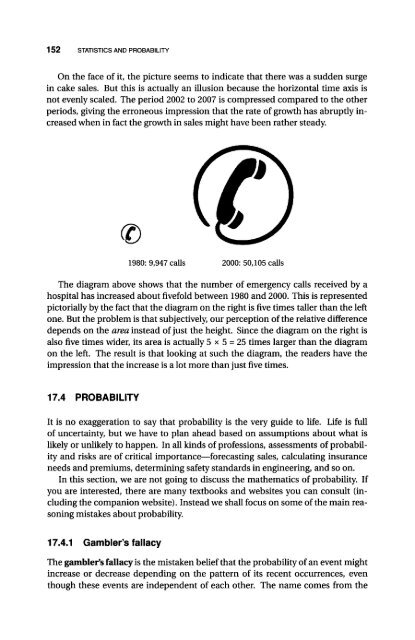An Introduction to Critical Thinking and Creativity - always yours
An Introduction to Critical Thinking and Creativity - always yours
An Introduction to Critical Thinking and Creativity - always yours
You also want an ePaper? Increase the reach of your titles
YUMPU automatically turns print PDFs into web optimized ePapers that Google loves.
152 STATISTICS AND PROBABILITY<br />
On the face of it, the picture seems <strong>to</strong> indicate that there was a sudden surge<br />
in cake sales. But this is actually an illusion because the horizontal time axis is<br />
not evenly scaled. The period 2002 <strong>to</strong> 2007 is compressed compared <strong>to</strong> the other<br />
periods, giving the erroneous impression that the rate of growth has abruptly increased<br />
when in fact the growth in sales might have been rather steady.<br />
» (D<br />
1980: 9,947 calls 2000: 50,105 calls<br />
The diagram above shows that the number of emergency calls received by a<br />
hospital has increased about fivefold between 1980 <strong>and</strong> 2000. This is represented<br />
pic<strong>to</strong>rially by the fact that the diagram on the right is five times taller than the left<br />
one. But the problem is that subjectively, our perception of the relative difference<br />
depends on the area instead of just the height. Since the diagram on the right is<br />
also five times wider, its area is actually 5 x 5 = 25 times larger than the diagram<br />
on the left. The result is that looking at such the diagram, the readers have the<br />
impression that the increase is a lot more than just five times.<br />
17.4 PROBABILITY<br />
It is no exaggeration <strong>to</strong> say that probability is the very guide <strong>to</strong> life. Life is full<br />
of uncertainty, but we have <strong>to</strong> plan ahead based on assumptions about what is<br />
likely or unlikely <strong>to</strong> happen. In all kinds of professions, assessments of probability<br />
<strong>and</strong> risks are of critical importance—forecasting sales, calculating insurance<br />
needs <strong>and</strong> premiums, determining safety st<strong>and</strong>ards in engineering, <strong>and</strong> so on.<br />
In this section, we are not going <strong>to</strong> discuss the mathematics of probability. If<br />
you are interested, there are many textbooks <strong>and</strong> websites you can consult (including<br />
the companion website). Instead we shall focus on some of the main reasoning<br />
mistakes about probability.<br />
17.4.1 Gambler's fallacy<br />
The gambler's fallacy is the mistaken belief that the probability of an event might<br />
increase or decrease depending on the pattern of its recent occurrences, even<br />
though these events are independent of each other. The name comes from the
















